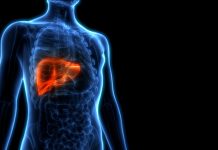
Dr Zeynep Madak-Erdogan and Qianying Zuo of the University of Illinois explain how an estrogen compound may be used to benefit postmenopausal women.
Non-alcoholic fatty liver disease (NAFLD) is the most common cause of liver damage, being one of the primary reasons for liver transplants. The disease is common, affecting nearly one in four people worldwide. Postmenopausal women are at an increased risk of developing NAFLD as metabolic changes cause a loss of estrogen.
NAFLD is worsened by a high-fat diet, which can cause the disease to progress to liver failure and cirrhosis. A healthy diet and physical activity should be encouraged for middle-aged women as they approach the menopause, to reduce the risk of developing NAFLD.
Hormone treatment replacement therapy (HRT) may also benefit postmenopausal women. Although this treatment method is effective in relieving symptoms, HRT increases the risk of breast cancer and cardiovascular disease. Therefore, a treatment without these negative side effects needs to be considered.
Now, University of Illinois researchers have detected a novel estrogen compound, pathway preferential estrogens, which relieve postmenopausal symptoms in the same way that HRT does, but without the increased risk factors.
Here, HEQ spoke to Dr Zeynep Madak-Erdogan and Qianying Zuo about this research and discussed the potential benefits of using pathway preferential estrogens as a treatment method for postmenopausal women.
Why are postmenopausal women at increased risk of developing NAFLD?
Estrogens regulate many important functions in the body and have protective effects in many metabolic tissues, including the liver. Ovarian estrogen loss after menopause triggers systemic effects in metabolic tissues as well as food intake and satiety circuits in the brain, resulting in increased weight gain and change in the body fat accumulation profile, from a pear shape to an apple shape.
Increased subcutaneous and visceral fat in postmenopausal women are associated with systemic inflammation and oxidative stress that can lead to metabolic syndrome including cardiovascular disease, diabetes, and several cancers including breast cancer.
NAFLD is characterised by the presence of hepatic fat accumulation (>5% of liver weight) in the absence of significant alcohol abuse. Particularly in the liver, loss of estrogens amounts to alteration of gene expression programmes in liver cells that make it easier for the liver to accumulate fat.
What are the key challenges currently facing the treatment of NAFLD using hormone replacement therapy (HRT)?
Conventional HRT is supplementing women with hormones that are lost during the menopausal transition, which usually includes estrogen and progesterone components to mimic hormones created by the ovaries. Despite benefits to the metabolic tissues, current HRT use is reported to increase the risk of stroke, deep vein thrombosis, and breast and endometrial cancers. Their side effects are due to what is described as ‘classical genomic actions’ of estrogen receptors.
This risk/benefit profile is the main driver for clinical decisions as women at high risk of breast cancer or a stroke are not prescribed HRT. Another challenge is the timing of the start of the HRT. If women are about 10 years into their menopause, the events that lead to a stroke (damage to blood vessels, changes in cholesterol homeostasis) are already in place and therefore risk of stroke is unfortunately even higher if women start taking HRT later during menopause.
What are pathway preferential estrogens? What did your study reveal about the ways in which this compound affects the liver?
Pathway preferential estrogens (PaPEs) are synthetic estrogenic ligands that interact with the estrogen receptor to activate the extranuclear-initiated (non-genomic) signalling pathway, preferentially over the nuclear-initiated (‘genomic’) pathway. PaPEs regulate cell circuitries that control metabolic pathways without stimulating pathways that would drive stroke or reproductive system cancers. Thus, potentially, we would keep the effective metabolic and vascular protective activity of estrogens without increasing risk of other debilitating conditions that would be associated with HRT use.
How could pathway preferential estrogens be used to treat fibrosis and improve metabolic health? What benefits could this treatment offer compared to HRT?
In our paper, we showed that PaPEs prevented fibrosis. Fibrosis is a natural response to liver damage due to increased lipid accumulation and oxidation. As liver cells succumb to death under these pressures, specialised cells in the liver deposit a special type of protein called collagens to fill the gap and maintain the liver architecture. Unfortunately, collagens are not only structural proteins, but they also signal to the cells in the liver microenvironment.
In our studies, PaPEs significantly decreased liver weight and lipid accumulation in our mice models and lowered pathways associated with fatty acid metabolism, inflammation, and collagen deposition. Currently, studies are underway to understand if the PaPE effect on the fibrosis is a direct one or is due to PaPE activating other mechanisms that prevent damage to liver, preventing the fibrosis. Either way, a decrease in fibrosis reduces risk of non-alcoholic steatohepatitis (NASH), and associated risk for liver cancer.
What other preventative or protective lifestyle measures can postmenopausal women take to reduce their risk of developing liver problems?
A major driver of NAFLD is weight gain, type of food consumed, and lack of exercise. Consuming a healthy diet mostly composed of plant-based protein and regular exercise to maintain a healthy body weight is always a good idea. Avoiding alcohol, eating food rich in antioxidants etc. would further support liver health.
How do you expect to build on the results of your research so far?
We need to make sure that all those beneficial effects of PaPEs are obtained without any side effects. Assessing various organ systems for potential toxicities are currently underway and so far, PaPEs display a very safe profile, causing no unwanted effects even at very high concentrations. Bioavailability of PaPE is very good, which makes it ideal for oral ingestion. The aim is to eventually develop PaPE as an HRT alternative for women with metabolic disease.
Dr Zeynep Madak-Erdogan
Associate professor
Health Innovation Professor
Qianying Zuo
PhD student
Department of Food Science and Human Nutrition,
University of Illinois
illinois.edu
This article is from issue 20 of Health Europa Quarterly. Click here to get your free subscription today.






















